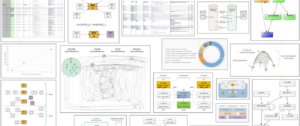Written by Dr. Andreas Martens
Why Traditional Data Management Fails in the Age of AI
Data Management for AI requires a fundamental shift in mindset. Traditional approaches focus on control, standardization, and certification. But modern AI systems like LLMs don’t consume polished dashboards. They rely on context-rich, semi-structured, and messy data. The way we manage information must evolve.
Instead of asking how to make data perfect, we should ask: How can we make data useful for machines?
The AI age calls for a new understanding of what data management should deliver. Not just governance, not just compliance, but intelligent adaptability.
From Control to Enablement: A Necessary Paradigm Shift
Classic data initiatives aim to clean, structure, and standardize. But modern AI models thrive on variability, ambiguity, and scale. The goal must shift from single sources of truth to machine-ready contexts. This means moving beyond tidy schemas into a world where loosely structured content becomes a first-class citizen.
So how should organizations move forward? Below are 7 concrete shifts in thinking that enable effective data management in AI-centric environments.
7 Key Shifts in Data Management for AI
1. Accept that AI thrives on messy, ambiguous data
Instead of endlessly normalizing information, embrace the richness of real-world signals. Social media posts, support tickets, emails, sensor logs, these are messy but immensely valuable. LLMs extract patterns and meaning precisely from that messiness. Your goal is not to sanitize it away, but to structure just enough to make it accessible.
Accept fuzziness as a feature, not a flaw.
2. Treat semantic ambiguity as a design challenge, not a bug
Many domain terms are fuzzy, contextual, and disputed, and that’s okay. Don’t waste energy on premature standardization. Instead, define semantic boundaries based on actual use cases. AI models can accommodate overlapping concepts if you clearly surface them.
Ambiguity is not a data quality issue. It’s a signal to be modeled.
3. Use semantic anchoring where structure matters
Not all structure is bad. In fact, machine reasoning often benefits from lightweight ontologies, semantic labels, or entity linking. This is especially relevant in hybrid systems combining LLMs with symbolic rules or graphs. Use structure deliberately, not everywhere, but where it adds value.
Anchor meaning where precision is required, not across the board.
4. Focus on making data queriable, not certified
Most teams still try to “clean up” data until it passes a quality gate. But for AI applications, usefulness beats cleanliness. Prioritize making data accessible via APIs, embeddings, or search. Think in terms of retrievability: how quickly can a model or person find what they need?
Good enough and accessible beats perfect but hidden.
5. Separate truth from relevance
Many pipelines aim to enforce correctness. But LLMs do not care whether something is 100 percent accurate. They care whether it is relevant, representative, and recent. This is especially true in decision support, customer service, or sales applications. Build pipelines that surface context, not just facts.
For AI, context is often more valuable than ground truth.
6. Design data pipelines for machines, not only humans
Your dashboards are still important. But your data infrastructure should increasingly cater to machine consumption, via vector databases, feature stores, and APIs. This changes how you model metadata, define access policies, and prioritize updates (also read: How to Avoid Vendor-Lock-in).
Design with the end consumer in mind, and that consumer might be a model.
7. Make human knowledge machine-usable
The most valuable data often lives in people’s heads or in Word files, Notion pages, and Jira tickets. Convert this hidden knowledge into structured, machine-readable content. This is not about hardcoding everything into ontologies. It’s about creating bridges between human domain expertise and machine reasoning.
Data work is increasingly knowledge engineering.
How Data Teams Can Lead in AI-Driven Data Management
This shift does not make data teams obsolete. Quite the opposite. But their role evolves.
- They become enablers of machine intelligence, not just report builders.
- They translate human semantics into machine context, not just clean numbers.
- They manage retrievability, relevance, and representation, not just pipelines and storage.
This will require new tooling, yes. But above all, it requires new mental models.
Conclusion: Rethinking Data for Real Impact
The age of AI demands more than faster pipelines and bigger warehouses. It requires a complete reorientation of what data work is about. From perfect tables to useful signals. From rigid models to adaptive contexts. From governance to enablement.
Rethinking data management means rethinking how we create value from information for humans and machines.
We need a new kind of data management — pragmatic, end-to-end, impact-oriented.
Something designed for a future where AI agents take over the work, and data ecosystems become self-managing. Autonomous Data Products, like those described by Zhamak Dehghani → NextData OS, are already laying the groundwork.
We believe in this future.
Need to rethink your data setup for AI?
At qurix, we help businesses turn complex data landscapes into AI-ready ecosystems. From architecture design to implementation, we combine technical depth with strategic clarity. Get in touch for an expert perspective.



